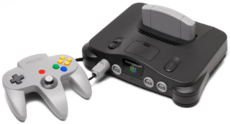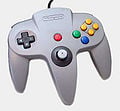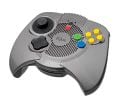Nintendo 64: Difference between revisions
m (Reverted ReiDemon: don't just remove it - justify your actions in the edit summary) |
mNo edit summary |
||
| (111 intermediate revisions by 63 users not shown) | |||
| Line 1: | Line 1: | ||
{{ArticleIcons|ssb=y}} | |||
{{Infobox Game System | {{Infobox Game System | ||
|title = Nintendo 64 | |title = Nintendo 64 | ||
|logo = | |logo = [[File:Nintendo 64 logo.svg|200x93px]] | ||
|image= [[ | |image= [[File:N64.png|230px]] | ||
|manufacturer = [[Nintendo]] | |manufacturer = [[Nintendo]] | ||
|type = Video game console | |type = Video game console | ||
|generation = [[wikipedia:History of video game consoles (fifth generation)|Fifth generation]] | |generation = [[wikipedia:History of video game consoles (fifth generation)|Fifth generation]] | ||
|lifespan = {{Japan}} | |lifespan = {{Flag|Japan}} June 23, 1996<br>{{Flag|North America}} September 29, 1996<br>{{Flag|Europe}} March 1, 1997<br>{{Flag|Australia}} March 1, 1997<br>{{Flag|South Korea}} July 19, 1997<br>{{Flag|Brazil}} December 10, 1997 | ||
| | |||
| | |||
|media = ROM cartridge | |media = ROM cartridge | ||
|controllers = [[Nintendo 64 controller]] | |||
|controllers = | |||
|compatibility = | |compatibility = | ||
|predecessor = | |predecessor = Super Nintendo Entertainment System | ||
|successor = [[Nintendo GameCube]] | |successor = [[Nintendo GameCube]] | ||
|interwiki = nwiki | |||
|interwikiname = Nintendo Wiki | |||
|interwikipage = Nintendo 64 | |||
}} | }} | ||
The '''Nintendo 64''' ({{ja|ニンテンドー64|Nintendō Rokujūyon}}, ''Nintendo 64''), often abbreviated as '''N64''', is [[Nintendo]]'s third home video game console for the international market. Named for its 64-bit processor, it was first announced in 1993 as the ''Nintendo Ultra 64'' before being delayed and dropping the "Ultra" part of its name when it debuted on June 23, 1996 in Japan, and was later released in North America on September 29, 1996, and in Europe and Australia on March 1, 1997. The Nintendo 64 was the first Nintendo console to natively support 3D polygonal graphics, a concept they previously dabbled in with projects like the Super FX Chip. As a fifth-generation console, the Nintendo 64 competed primarily with newcomer {{iw|wikipedia|Sony}}'s {{iw|wikipedia|PlayStation|console}} and the {{iw|wikipedia|Sega Saturn}}. At 32.93 million units sold worldwide, the N64 sold significantly less than its predecessor, the {{iw|nintendowiki|Super Nintendo Entertainment System}}, and its primary competitor, the Sony PlayStation. The Nintendo 64 did however overall outsell its other competitor, the Sega Saturn (though the Saturn outsold it in Japan). The N64 marked the first time that Nintendo did not lead a console generation in terms of sales as it did previously with the NES and SNES, having lost to Sony's PlayStation. This decline is mainly due to decisions like sticking to cartridge media, which had severely limited storage and functionality compared to new digital storage devices like the CD-ROM, as well as their now antiquated mandate that publishers must exclusively publish on Nintendo consoles, forced important third party publishers to abandon the console early on, creating a small game library and thus little reason for the average consumer to buy one. This decline of Nintendo console sales would continue over with the [[Nintendo GameCube]] until the [[Wii]] was released to great fanfare and commercial success, before declining again with the [[Wii U]]. | |||
Another version of the Nintendo 64, called the '''iQue Player''' (神游機) is a video game system made by iQue Ltd., Nintendo's Chinese subsidiary and released on November 17, 2003. It is a plug-and-play variation of the Nintendo 64 hardware, specifically designed for the Chinese market. The original ''[[Super Smash Bros.]]'' was ported to the iQue Player on November 15, 2005. Production for the Nintendo 64 ended in Japan in 2002 and worldwide in 2003. | |||
==In the ''{{b|Super Smash Bros.|series}}'' series== | |||
On January 21, 1999, the original ''[[Super Smash Bros.]]'' was released for the Nintendo 64 in Japan, which was later released in North America that April. While not the best-selling game on the N64, it was the predecessor of ''[[Super Smash Bros. Melee]]'' which became the [[Nintendo GameCube]]'s best selling title and spawned a successful series, ''{{b|Super Smash Bros.|series}}'' | |||
A Nintendo 64 can be seen in the trophy room in ''Super Smash Bros. Melee'', with a copy of ''Super Smash Bros.'' | |||
Throughout the years, many characters that debuted in games originally released for the Nintendo 64 became playable fighters in the ''Super Smash Bros.'' series: | |||
*[[Sheik]], [[Ganondorf]] and [[Young Link]] in ''[[Melee]]''. | |||
*[[Wolf]] in ''[[Brawl]]''. | |||
*[[Villager]] in ''[[SSB4]]''. | |||
*[[Banjo]] & [[Kazooie]] in ''[[Ultimate]]''. | |||
Additionally, [[Lucas]]'s debut game, ''Mother 3'', was slated to release on the Nintendo 64, but this iteration of the game was cancelled, and the project was later revived on the Game Boy Advance. | |||
{{ | ==In competitive play== | ||
Due to being the original hardware the game was designed for, the Nintendo 64 is the preferred system to play ''Smash 64'', especially in tournaments. While there are other options like the iQue Player and emulators like Wii Virtual Console and Project 64, some have specific bugs and performance issues not present on official hardware, in addition to the Wii Virtual Console not being legitimately available as of January 2019. However, the aging hardware that is becoming progressively less reliable have forced the competitive scene to consider and experiment with these alternatives before the game becomes unplayable, and have made great strides in making a nearly identical experience. | |||
Just like how it is possible to dump N64 cartridge data onto other systems, some have found ways to make their own cartridges that work on original hardware and dump data from other systems onto them. This allows [[mod]]s and fan-games to be played on original hardware, including the many based on ''Smash 64''. | |||
==Gallery== | |||
<gallery> | |||
N64-controller.jpg|The Nintendo 64 controller. | |||
N64-catridge.jpg|The Nintendo 64 cartridge. | |||
N64-rumble-pak.jpg|The Nintendo 64 Rumble Pak. Has compatibility with ''[[Super Smash Bros.]]'' | |||
Iqueplayer.jpg|The iQue Player. | |||
</gallery> | |||
==External links== | |||
*[http://www.ique.com/M_Player.htm iQue Player website], in Chinese. | |||
{{Consoles}} | |||
[[Category:Nintendo 64| ]] | |||
[[Category:Consoles]] | [[Category:Consoles]] | ||
Latest revision as of 14:22, January 5, 2024
| Nintendo 64 | |
|---|---|
 
| |
| Manufacturer | Nintendo |
| Type | Video game console |
| Generation | Fifth generation |
| First available | |
| Media | ROM cartridge |
| Controller input | Nintendo 64 controller |
| Predecessor | Super Nintendo Entertainment System |
| Successor | Nintendo GameCube |
| Article on Nintendo Wiki | Nintendo 64 |
The Nintendo 64 (ニンテンドー64, Nintendo 64), often abbreviated as N64, is Nintendo's third home video game console for the international market. Named for its 64-bit processor, it was first announced in 1993 as the Nintendo Ultra 64 before being delayed and dropping the "Ultra" part of its name when it debuted on June 23, 1996 in Japan, and was later released in North America on September 29, 1996, and in Europe and Australia on March 1, 1997. The Nintendo 64 was the first Nintendo console to natively support 3D polygonal graphics, a concept they previously dabbled in with projects like the Super FX Chip. As a fifth-generation console, the Nintendo 64 competed primarily with newcomer Sony's PlayStation and the Sega Saturn. At 32.93 million units sold worldwide, the N64 sold significantly less than its predecessor, the Super Nintendo Entertainment System, and its primary competitor, the Sony PlayStation. The Nintendo 64 did however overall outsell its other competitor, the Sega Saturn (though the Saturn outsold it in Japan). The N64 marked the first time that Nintendo did not lead a console generation in terms of sales as it did previously with the NES and SNES, having lost to Sony's PlayStation. This decline is mainly due to decisions like sticking to cartridge media, which had severely limited storage and functionality compared to new digital storage devices like the CD-ROM, as well as their now antiquated mandate that publishers must exclusively publish on Nintendo consoles, forced important third party publishers to abandon the console early on, creating a small game library and thus little reason for the average consumer to buy one. This decline of Nintendo console sales would continue over with the Nintendo GameCube until the Wii was released to great fanfare and commercial success, before declining again with the Wii U.
Another version of the Nintendo 64, called the iQue Player (神游機) is a video game system made by iQue Ltd., Nintendo's Chinese subsidiary and released on November 17, 2003. It is a plug-and-play variation of the Nintendo 64 hardware, specifically designed for the Chinese market. The original Super Smash Bros. was ported to the iQue Player on November 15, 2005. Production for the Nintendo 64 ended in Japan in 2002 and worldwide in 2003.
In the Super Smash Bros. series[edit]
On January 21, 1999, the original Super Smash Bros. was released for the Nintendo 64 in Japan, which was later released in North America that April. While not the best-selling game on the N64, it was the predecessor of Super Smash Bros. Melee which became the Nintendo GameCube's best selling title and spawned a successful series, Super Smash Bros.
A Nintendo 64 can be seen in the trophy room in Super Smash Bros. Melee, with a copy of Super Smash Bros.
Throughout the years, many characters that debuted in games originally released for the Nintendo 64 became playable fighters in the Super Smash Bros. series:
- Sheik, Ganondorf and Young Link in Melee.
- Wolf in Brawl.
- Villager in SSB4.
- Banjo & Kazooie in Ultimate.
Additionally, Lucas's debut game, Mother 3, was slated to release on the Nintendo 64, but this iteration of the game was cancelled, and the project was later revived on the Game Boy Advance.
In competitive play[edit]
Due to being the original hardware the game was designed for, the Nintendo 64 is the preferred system to play Smash 64, especially in tournaments. While there are other options like the iQue Player and emulators like Wii Virtual Console and Project 64, some have specific bugs and performance issues not present on official hardware, in addition to the Wii Virtual Console not being legitimately available as of January 2019. However, the aging hardware that is becoming progressively less reliable have forced the competitive scene to consider and experiment with these alternatives before the game becomes unplayable, and have made great strides in making a nearly identical experience.
Just like how it is possible to dump N64 cartridge data onto other systems, some have found ways to make their own cartridges that work on original hardware and dump data from other systems onto them. This allows mods and fan-games to be played on original hardware, including the many based on Smash 64.
Gallery[edit]
The Nintendo 64 Rumble Pak. Has compatibility with Super Smash Bros.
External links[edit]
- iQue Player website, in Chinese.
| Nintendo consoles | |
|---|---|
| Home consoles | Color TV-Game 15 · Nintendo Entertainment System · Super Nintendo Entertainment System · Virtual Boy · Nintendo 64 · Nintendo GameCube · Wii · Wii U |
| Handheld consoles | Game & Watch · Game Boy · Game Boy Color · Game Boy Advance · Nintendo DS · Nintendo 3DS |
| Hybrid consoles | Nintendo Switch |



